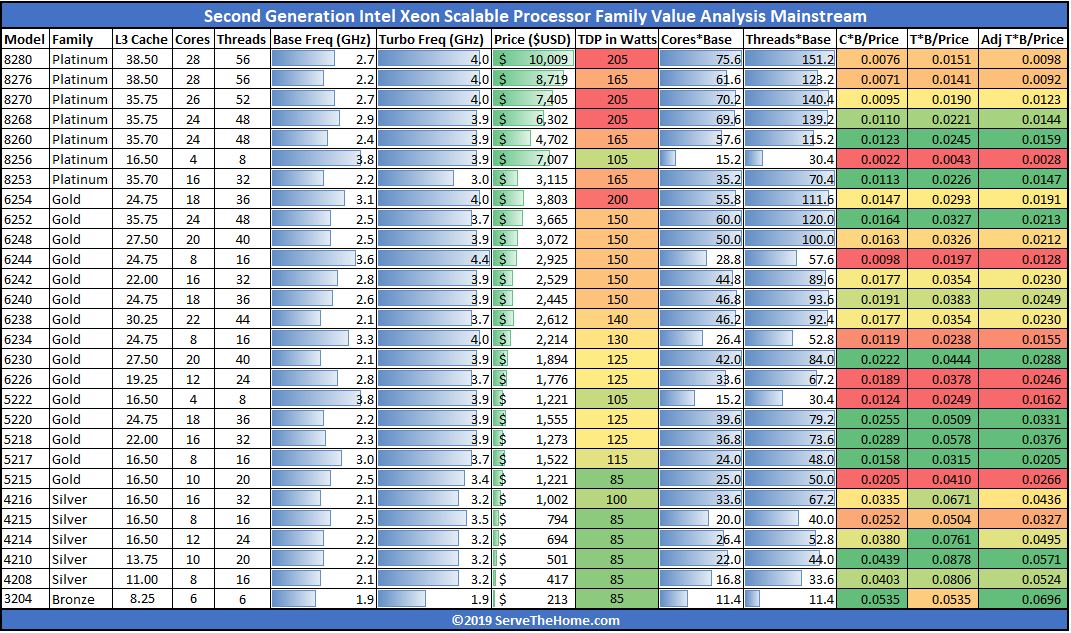Intel Xeon Gold 6230 Market Positioning
Thes chips are not released in a vacuum instead, they have competition on both the Intel and AMD sides. When you purchase a server and select a CPU, it is important to see the value of a platform versus its competitors.
Intel Xeon Gold 6230 v. Intel Alternatives
It is hard not to like the Intel Xeon Gold 6230. At around $1900 and with 20 cores, it offers some of the best performance per dollar in the second generation Intel Xeon Scalable range. Here is a chart from our Second Generation Intel Xeon Scalable SKU List and Value Analysis piece that illustrates the lineup and where the Intel Xeon Gold 6230 falls:

Given the system pricing is dominated by parts other than two $1900 CPUs, we generally would suggest the Intel Xeon Gold 6230 is a strong upgrade over the Intel Xeon Gold 5220 and Gold 5218.
If you are still looking for 16-core performance to meet licensing buckets, such as with Microsoft Windows Server, you will want to use the Intel Xeon Gold 6242 instead as that is a much stronger part here.
Intel Xeon Gold 6230 v. AMD EPYC Alternatives
At the time of this writing, the current generation of AMD product is the AMD EPYC 7001 series. If you are looking at the Intel Xeon Platinum for quad-socket servers, or with Intel Optane DCPMM, then AMD EPYC is not direct competition at the time of this writing.
The 2017 era “Naples” AMD EPYC generation this chip sits around the price of a 24-core SKU, the AMD EPYC 7401 (non-P.) We think Intel is now very competitive with higher clock speeds and a monolithic die offsetting a lower core count.
In the AMD EPYC “Rome” generation we expect that the company will have up to 64 cores in a single socket. When this happens, Intel is going to have to figure out how it will compete with chips that cost less and can offer better than 2:1 consolidation ratios for sockets. Additionally, the new parts will have more PCIe lanes and using Gen4 speeds that are twice as fast.
What will be interesting to see is what happens when AMD is able to have two 48-core “Rome” CPUs in a system versus four Intel Xeon Gold 6230 SKUs. Unfortunately, we only had two Gold 6230 CPUs to test, but the consolidation threat is there.
Final Words
Comparing the Intel Xeon Gold 6230 to its contemporaries around the end of Q2 2019 and early Q3, the chip is awesome. We are seeing 20-25% more performance at the same TDP. There are also new security mitigations, Intel VNNI for AI inferencing, Intel Optane DCPMM support, and scalability to 4-socket servers.
If you are not tied to licensing in 16 core increments, then we wholeheartedly suggest upgrading new server purchases from the Gold 6130 to the Intel Xeon Gold 6230. The value one derives in this range now has seen a step-function like improvement. Competition is good, and AMD’s new chips are making Intel react providing more value per dollar than they have had to in almost a decade.




Can you make a short comparison of the 6230 against 6230N & 6248 ?
It’ll be interesting to see how performance scales up with the clock speed
and whether the increase of the performance justify the prices.
Hi Zibi, we are happy to. Do you have chips we can use?
We are a bit limited by the fact Intel has so many SKUs that we usually can only get 50-60% of the main SKU stack.
Hello Patrick
Unfortunately no.
I’m trying to get some 6230N as the demo inside 2U 4CPU system, but so far not much of the success.
They are really in the limited availability and not many vendors seems to have them, or plan to have them in the package I want.
BTW. Thank you for the great work!
Nice comparison!
6130/6230 are excellent cpu choice!
Would you be able to compare at least three generations of cpus? For instances 6230, 6130, and probably 2640 v4? This would help people looking for upgrade. Also, another idea would be to not remove cpus from your benchmarks and in a few years you’ll get a big enough history
Hi, in the first page it says “… we are then going to focus on power consumption then conclude with our final words on the processors.”, but I can’t find the part where you focus on power consumption. Is it the part on page 2 comparing TDPs? I’m curious about whether you measured the power consumption between the Intel generations and also how the AMD machines compare.